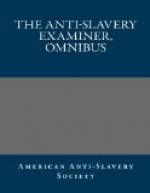Mr. Benjamin Clendenon, Colerain, Lancaster Co., Pa., a member of the Society of Friends, in a recent letter describing a short tour through the northern part of Maryland in the winter of 1836, thus speaks of a place a few miles from Chestertown. “About this place there were a number of slaves; very few, if any, had either stockings or shoes; the weather was intensely cold, and the ground covered with snow.”
The late Major Stoddard of the United States’ artillery, who took possession of Louisiana for the U.S. government, under the cession of 1804, published a book entitled “Sketches of Louisiana,” in which, speaking of the planters of Lower Louisiana, he says, “Few of them allow any clothing to their slaves.”
The following is an extract from the Will of the late celebrated John Randolph of Virginia.
“To my old and faithful servants, Essex and his wife Hetty, I give and bequeath a pair of strong shoes, a suit of clothes and a blanket each, to be paid them annually; also an annual hat to Essex.”
No Virginia slaveholder has ever had a better name as a “kind master,” and “good provider” for his slaves, than John Randolph. Essex and Hetty were favorite servants, and the memory of the long uncompensated services of those “old and faithful servants,” seems to have touched their master’s heart. Now as this master was John Randolph, and as those servants were “faithful,” and favorite servants, advanced in years, and worn out in his service, and as their allowance was, in their master’s eyes, of sufficient moment to constitute a paragraph in his last will and testament, it is fair to infer that it would be very liberal, far better than the ordinary allowance for slaves.
Now we leave the reader to judge what must be the usual allowance of clothing to common field slaves in the hands of common masters, when Essex and Hetty, the “old” and “faithful” slaves of John Randolph, were provided, in his last will and testament, with but one suit of clothes annually, with but one blanket each for bedding, with no stockings, nor socks, nor cloaks, nor overcoats, nor handkerchiefs, nor towels, and with no change either of under or outside garments!
IV. DWELLINGS.
THE SLAVES ARE WRETCHEDLY SHELTERED AND LODGED.
Mr. Stephen E. Maltby. Inspector of provisions, Skaneateles, N.Y. who has lived in Alabama.
“The huts where the slaves slept, generally contained but one apartment, and that without floor.”
Mr. George A. Avery, elder of the 4th Presbyterian Church, Rochester, N.Y. who lived four years in Virginia.
“Amongst all the negro cabins which I saw in Va., I cannot call to mind one in which there was any other floor than the earth; any thing that a northern laborer, or mechanic, white or colored, would call a bed, nor a solitary partition, to separate the sexes.”




